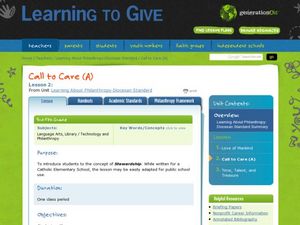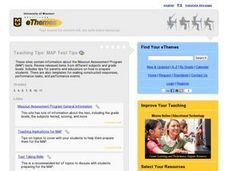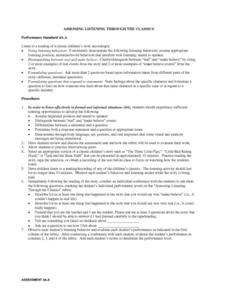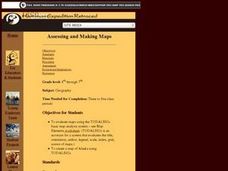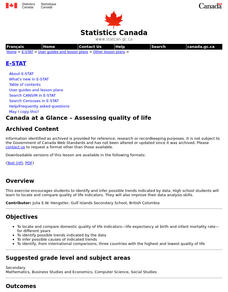Curated OER
Bearly There
First graders read "How Long Is A Foot?" together and use paper clips, teddy bears, crayons and other non-standard units to measure items. They compare the items measured and order them from longest to shortest.
Curated OER
Learning About Philanthropy - Diocesan Standard
Students identify the concept of stewardship. In this stewardship lesson, students create stewardship lists, complete stewardship surveys, and learn six new words related to stewardship by listing them in acrostic poem.
Curated OER
Measuring Fun
First graders practice measuring. In this measuring lesson, 1st graders read the story How Big Is a Foot? by Rolf Myller. They measure a partner using standard (ruler) and nonstandard (feet) units.
Curated OER
Polynomials
Students add and subtract polynomials. In this polynomials assessment, students calculate ten questions using addition and subtraction. Students use Lego manipulatives to create their own worksheet on polynomials.
Curated OER
MAP Test Tips
Students visit sites designed to prepare them for the Missouri Assessment Program tests. They visit Web sites containing skills practice for the test.
Curated OER
Watch Out
Students assess a time-related scenario at a railroad station. They study about the importance of a synchronized time system at Grand Central Terminal.They research various time measurement devices and develop "How It Works" posters...
Curated OER
ASSESSING LISTENING THROUGH THE CLASSICS
Students demonstrate listening behaviors. They assume appropriate listening position, minimize/avoid behaviors that interfere with listening, and attend to speaker. They distinguish between real and make believe and cite 2 or more...
Curated OER
Self-Assessment: Habits of Effective Readers, Writers, Speakers, Listeners, and Viewers
Fifth graders study how to read fluently. In this reading instructional activity, 5th graders practice reading and recording any miscues. Students time each other and graph their progress each day.
Curated OER
Slopes, Slope-Intercept Form, Standard Form
Students identify the slope of an equation using various methods. In this algebra lesson, students graph linear equations and calculate the slopes using the x and y intercept to solve the equations and graph the lines. They use the slope...
Curated OER
Assessing and Making Maps
Students evaluate maps using the TODALSIGs basic map analysis system, explained on the worksheet. They create a map of Alaska using TODALSIGs. Students brainstorm the elements of maps.
Curated OER
Assessing Quality of Life
Eleventh graders research quality of life indicators for a list of countries looking at such things as infant mortality rate, and gross domestic product. They rank the countries from best to worst regarding quality of life issues.
Curated OER
Assessing Presenting the Mask
Eighth graders use a software program to recreate a mask they made in art class. Individually, they write a paper describing their mask with an loose illustration. They combine the pictures of each mask into a class book for others to view.
Curated OER
Length and Volume Exploration
Students explore how to measure length and volume. They compare and order objects according to their measurable attributes and measure items using non-standard units. Students put 4 pencils in order from shortest to longest after...
National Research Center for Career and Technical Education
Health Science: Back to Basics
This lesson focuses on unit conversion, proportions, ratios, exponents, and the metric system. Discuss measurement with your math class and demonstrate how to solve several health-science word problems. Give learners a chance to visit an...
Curated OER
Assessing the Traits: What is Good Writing?
Students assess samples of writing for each trait and discuss the rationale for scoring. They understand that the traits of writing offer a common language for revision. This lesson includes a scoring rubric for the students to use.
Curated OER
Licensing Standards
Students examine standards for obtaining a license to run a day care. They study ratios for age groups and answer questions on improving public policy. They identify current childcare licensing standards and laws and what they could...
NASA
A Different Perspective
What can we learn from the data? Young scholars analyze actual solar data to answer specific questions. The activity presents an opportunity for an open-ended investigation of the data to conclude a five-part series on solar winds.
Curated OER
Measuring Up
Students examine and discuss a variety of ways to measure length, capacity, and weight. They estimate and measure a pencil's length using Unifix cubes, estimate and fill a measuring cup with Unifix cubes, and weigh a calculator in a...
EngageNY
Grade 10 ELA Module 3: Unit 1, Lesson 15
It's time for the grand finale! Scholars finalize their learning in a two-part end-of-unit assessment. This assessment covers multiple standards as learners demonstrate their understanding of the central idea, comprehension, and...
Curated OER
A Weigh we Go!
Here are some cross-curricular activities whil should help your kids understnad weight measurements and grammar. In this grammar and math lesson, learners read the book Skittles Riddles and practice counting and balancing skittles. They...
Curated OER
Graphing Practice
Click on the download box to access this useful graphing lesson that includes worksheets for homework, assessment, and classroom work. The class graphs basic linear functions. They rewrite the equations from standard form into...
Curated OER
Comet Myths, Facts, and Legends
Here is an interactive book lesson through which learners explore the facts and stories about comets. The plan is comprehensive, providing background information, standards met, vocabulary, assessment ideas, and more. Though the content...
Curated OER
Organic Farming / Agriculture
Want an organic farming resource packed with experiments, background information, science fair projects, and topics of interest for further research? Here it is. Young environmental scientists can explore concepts involved in organic...
Curated OER
My School Goal (Part 3)
Third graders, while working in small groups, determine the meaning of evaluation and why they are evaluated in school. They individually assess themselves to determine how they did on their goal sheet, and prepare to continue the use of...

